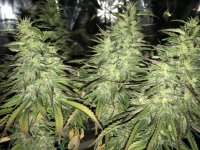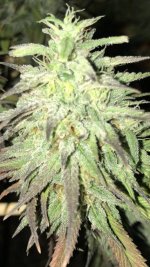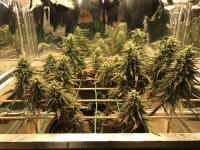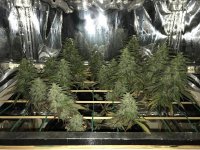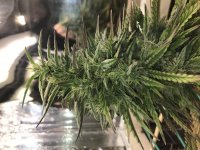-
ICMag with help from Phlizon, Landrace Warden and The Vault is running a NEW contest for Christmas! You can check it here. Prizes are: full spectrum led light, seeds & forum premium access. Come join in!
You are using an out of date browser. It may not display this or other websites correctly.
You should upgrade or use an alternative browser.
You should upgrade or use an alternative browser.
DIY LED CXB3590 2700K 32VDC X 6 (grow light)
- Thread starter acespicoli
- Start date
acespicoli defiantly digging your knowledge and curiosity.
Im real intereested in mixing spectrums. Back in my HID days i would always mix MH and HPS in flower. Always thought it gave me superior results.
Right now I am running 4 CXB 3590CD BIN at 3500k 36v on a 1400 meanwell driver at maybe 1.1 amps ~Hard to tell exactly because the dial is n small and unmarked. Two COBS per heat sink. Two heat sinks.
I also threw in 3 ~ 55w fluorescent PL-L lights in between the COB heatsinks to play with spectrum. I have interchangeably 3000K ~4100K and 6500K PL-L's to mix. Three lights at a time. So far im keeping the combinations to two spectrums. Not all three PL-L spectrums are in at once time ~ 2:1 ratio with constant COB's as the workhorse's. I do 2:1 ratio so I get even light disbursement on the canopy if that makes sense.
So far I have done a full grow with one 6500K PL-L in the middle and two 4100K 's on the ends. I was happy but no scientific measurements were taken lol
This grow I started with the same set up and just switched tonight so the last 3 weeks will get one 4100K in the middle (replacing the one 6500K) and now two 3000K on the edges ( replacing the two 4100K)
So as of tonight I have traded eliminated my 6500K and put in two more 3000K PL-l's
Im totally just having fun but wanted to get the hives thoughts on this spectrum combo in late flower.
Im real intereested in mixing spectrums. Back in my HID days i would always mix MH and HPS in flower. Always thought it gave me superior results.
Right now I am running 4 CXB 3590CD BIN at 3500k 36v on a 1400 meanwell driver at maybe 1.1 amps ~Hard to tell exactly because the dial is n small and unmarked. Two COBS per heat sink. Two heat sinks.
I also threw in 3 ~ 55w fluorescent PL-L lights in between the COB heatsinks to play with spectrum. I have interchangeably 3000K ~4100K and 6500K PL-L's to mix. Three lights at a time. So far im keeping the combinations to two spectrums. Not all three PL-L spectrums are in at once time ~ 2:1 ratio with constant COB's as the workhorse's. I do 2:1 ratio so I get even light disbursement on the canopy if that makes sense.
So far I have done a full grow with one 6500K PL-L in the middle and two 4100K 's on the ends. I was happy but no scientific measurements were taken lol
This grow I started with the same set up and just switched tonight so the last 3 weeks will get one 4100K in the middle (replacing the one 6500K) and now two 3000K on the edges ( replacing the two 4100K)
So as of tonight I have traded eliminated my 6500K and put in two more 3000K PL-l's
Im totally just having fun but wanted to get the hives thoughts on this spectrum combo in late flower.
Thanx Monarch,
Those PL-L put out some lumens I had no idea it was that high, how close do you keep them from the canopy if you run them alone? Do they run cool to the touch?
Those PL-L put out some lumens I had no idea it was that high, how close do you keep them from the canopy if you run them alone? Do they run cool to the touch?
Thanx Monarch,
Those PL-L put out some lumens I had no idea it was that high, how close do you keep them from the canopy if you run them alone? Do they run cool to the touch?
The three I run are on the same timer as my COB's, so they run for the full 12 hrs. This light is flower box only, so no vegging happens in it. I have considered starting them 15 mins early and shutting off 15 mins later than the LED's but haven't yet.
I forget my specs on the COB's, built the light a year ago, but I think its around 37K lumens with the COBS alone. The 3 55w PL-L's put up an extra 12K I believe roughly. They're around 3700-4k lumens each I believe.
I just view them as an extra "boost" if you will of other spectrums.
They are certainly weaker in penetration. My box is 22" deep x 28" wide and 48 high.
I built the light with even canopy dispersement in mind so I use a screen to keep the canopy even. They don't run hot really. There is added temps to the box but the leds actually produce more heat on the sink and the box overall. I prioritize the led height first so the the PL-L's are getting nowhere around close enough to burn the plants.
heres my first grow, you can see the overall set up.
Ideally they would want to be much closer than the cobs, as close as you can get without burn but like i said i just view them as a 'Boost".. There not getting their full potential up there next to the LED's but they mix in well.
Heres my current grow. went on vacation and had a friend fuck up feeding, so I lost all my fan leaves but the plants still doing pretty well by my accord.
She gets a pretty good diet or earthworm juice and compost tea I brew.
lights out
lights on
Attachments
That is awesome monarch,
Really nice looking grow I like the scrog inside it makes the stretch much more manageable your right
Your numbers for lumens are right on.
This is a nice touch > earthworm juice and compost tea... once weekly?
You have a organic soil mix your using too most likely?
You know I just thought the leaf loss was lolly popping
They have a aquarium light controller called bluefish (I had thought of getting a more natural on off cycle) I agree on this being better in theory.
I just recently added side fluorescents 4 tubes on 2 of 4 vertical walls to light the lower canopy and add supplemental light and im not sure but it seems to have stalled the stretch a little. Pulling plants more to the sides than just straight up, im gonna have to do some more observations to see if its really working. Kinda like east west light?
Really nice looking grow I like the scrog inside it makes the stretch much more manageable your right
Your numbers for lumens are right on.
This is a nice touch > earthworm juice and compost tea... once weekly?
You have a organic soil mix your using too most likely?
You know I just thought the leaf loss was lolly popping
They have a aquarium light controller called bluefish (I had thought of getting a more natural on off cycle) I agree on this being better in theory.
I just recently added side fluorescents 4 tubes on 2 of 4 vertical walls to light the lower canopy and add supplemental light and im not sure but it seems to have stalled the stretch a little. Pulling plants more to the sides than just straight up, im gonna have to do some more observations to see if its really working. Kinda like east west light?
$100.00 USD
Designed specifically for immensely popular Mean Well LDD-H drivers, the Bluefish Mini is a case-less module that brings many of the lighting features of Bluefish for about half the price. This model targets users building DIY fixtures, and manufacturers wishing to incorporate Bluefish directly into their fixtures or driver boxes.
The Bluefish Mini uses the same app and Wi-Fi connectivity of it’s bigger brother, but lacks analog output and BluePort expansion capabilities. The Bluefish Mini is only compatible with Mean Well LDD-H drivers.
Im not sure how good it is, I thought of building a arduino project light controller that would be very similar maybe add misters.
Its a fun hobby we can get as fancy as we want right?
[URL=https://www.icmag.com/ic/picture.php?albumid=70564&pictureid=1692268&thumb=1]View Image[/url] Bluefish Mini LDD Controller
$100.00 USD
Designed specifically for immensely popular Mean Well LDD-H drivers, the Bluefish Mini is a case-less module that brings many of the lighting features of Bluefish for about half the price. This model targets users building DIY fixtures, and manufacturers wishing to incorporate Bluefish directly into their fixtures or driver boxes.
The Bluefish Mini uses the same app and Wi-Fi connectivity of it’s bigger brother, but lacks analog output and BluePort expansion capabilities. The Bluefish Mini is only compatible with Mean Well LDD-H drivers.
Im not sure how good it is, I thought of building a arduino project light controller that would be very similar maybe add misters.
Its a fun hobby we can get as fancy as we want right?
Best hobby there is!
Its a rabbit hole for sure. I don't have that driver thought, but I do have three Arduino boards...I've been playing with them lightly, still haven't figured them out fully (lack of time) my goal is to first start data logging everything I can on temp / humidity / pH etc just for fun because I like to tinker.
But a natural lighting schedule would be fun. It would be easy I think to make a timer that mimicked fall decreasing light hours. Next step would be to dial into the potentiometer and adjust the brightness throughout peak hours like the sun. I don't know if it would have any benefit but it would be cool. I think overall you just want to make sure your plant is getting enough umols throughout the day.
My soil this run was fox farm oceans forest due to time constraints but I regularly mix my own up which started life as roots organic base with a combo of bought : rock dust (azomite - the Utah one), Alaskan hummus (general hydro? cant remember), crab shell meal - fish bone meal - kelp meal - oyster shell flour (down to earth), and a mixture of my earth worm castings and kitchen/garden compost.
I really wish I had been here to take care of the issues but Im expecting 2.5oz maybe. Im not sure what max I can get with these led's if I do my part right but I'm hoping to increase those numbers as I get this box more dialed in. In the past I have done two plants with better coverage. This is just one and I'm gonna equal last harvest easily with much better quality. Getting the compost brewer up and the earth worms in were huge.
Oh for feeding I just feed it the juice as long as they are producing. So its generally 5-6 cups a week.
Also I supplement with the above ferts. I also have some left over roots organic uprising bloom which I gave tablespoon topdressings throughout.
When I make a tea its usually with EWC or garden compost, rock dust, humic acid, kelp meal, and molasses. I try to do a brew once a week. All other watering are straight water.
Im not good with feeding regiments myself in that i don't keep track of anything really, just feels. Nothing has ever really gone wrong and the plants always seem to do fine but Im going to discipline myself next grow and record more.
When I make a tea its usually with EWC or garden compost, rock dust, humic acid, kelp meal, and molasses. I try to do a brew once a week. All other watering are straight water.
Im not good with feeding regiments myself in that i don't keep track of anything really, just feels. Nothing has ever really gone wrong and the plants always seem to do fine but Im going to discipline myself next grow and record more.
That is awesome monarch,
Really nice looking grow I like the scrog inside it makes the stretch much more manageable your right
Your numbers for lumens are right on.
This is a nice touch > earthworm juice and compost tea... once weekly?
You have a organic soil mix your using too most likely?
You know I just thought the leaf loss was lolly popping
They have a aquarium light controller called bluefish (I had thought of getting a more natural on off cycle) I agree on this being better in theory.
I just recently added side fluorescents 4 tubes on 2 of 4 vertical walls to light the lower canopy and add supplemental light and im not sure but it seems to have stalled the stretch a little. Pulling plants more to the sides than just straight up, im gonna have to do some more observations to see if its really working. Kinda like east west light?
what kind of side floros did you add? t5? what spectrums? I really like keeping blue in there for stretching. Ive read far red decreases stretching but I've noticed in my experience with floros that the blues always produced nice tight compact node spacing.
By Sirius J March 23, 2015
Cannabis researchers in Maryland exposed pot plants to ultraviolet radiation to see what would happen. They found that increasing doses of UVB radiation, a natural part of sunlight, made the plants produce almost 28% more THC in the buds.
In attempting to understand more about the function cannabinoids serve, the scientists discovered a relatively simple way to increase potency by a great margin. They ran the UVB experiment on both high-CBD hemp and potent Jamaican marijuana to see if the cannabinoid content would increase. Curiously enough, while THC increased in the Jamaican weed, the Czechoslovakian hemp received from the University of Mississippi did not produce more CBD.
So UVB radiation plays a role in THC production, but cannabinoids as a whole still retain their mystique. One fact can’t be denied: UVB radiation increases THC in strains that already express high THC.
How to take advantage of the effect
UV light intensity increases significantly at higher altitudes; the best hash plants in the world are grown in mountains and elevated regions. According to the National Weather Service, UV light increases “4-5% for every 1000 feet ascended." This means going from Phoenix to the top of the San Francisco Peaks increases UV radiation by 50%!
States like Arizona, New Mexico and Colorado receive some of the highest intensities of UV light with little cloud cover compared to northern states. Check out this map from the EPA to see your area.
Special fluorescent light bulbs generate radiation similar to natural UV light, and were used in the study. Growers put the plants under 40W Westinghouse FS-40 Sunlamps 10 inches from the canopy. Those exact light bulbs might be hard to find now, but similar, relatively inexpensive products are available in bulk and would be the best option for greenhouse-sized grows. The lights were filtered with cellulose acetate to remove the UVC spectrum—potent, damaging ultraviolet rays that are naturally filtered out by the ozone layer.
Micro and mini grow-ops can benefit from UVB supplementation, but need smaller bulbs. Desert reptiles like the bearded dragon require the radiation to make vitamin D, just as humans do. You can purchase a small UVB-emitting lamp at most pet stores. Mineral enthusiasts also use UVB lamps to make their rocks fluoresce, but the small handheld lamps are probably not potent enough for even a single plant.
There was a grower back in the day on grasscity forums i believe that was a reptile guy. He produced examples of snakes and lizards that only get certain colors in captivity due to lack of UV lighting. He had researched the available products very well and knew what was crap and what wasn't. He defiantly didn't buy anything from a reptile supplier or store. It certainly plays a role in the function of things that evolved under the sun here. I believe he was growing Nevilles haze, with some very beautiful results and purple color. This was maybe 9 years ago. Part of the reason I added the PL-L's to my fixture was the availability of 35 w UV bulbs for them. One day i might experiment with them.
(2) Yescom T5 2ft Grow Light 4x 3000K Tubes HO 24" Fluorescent
Hydroponic Fixture Bloom Planting Growing Lamps (8) lamps total
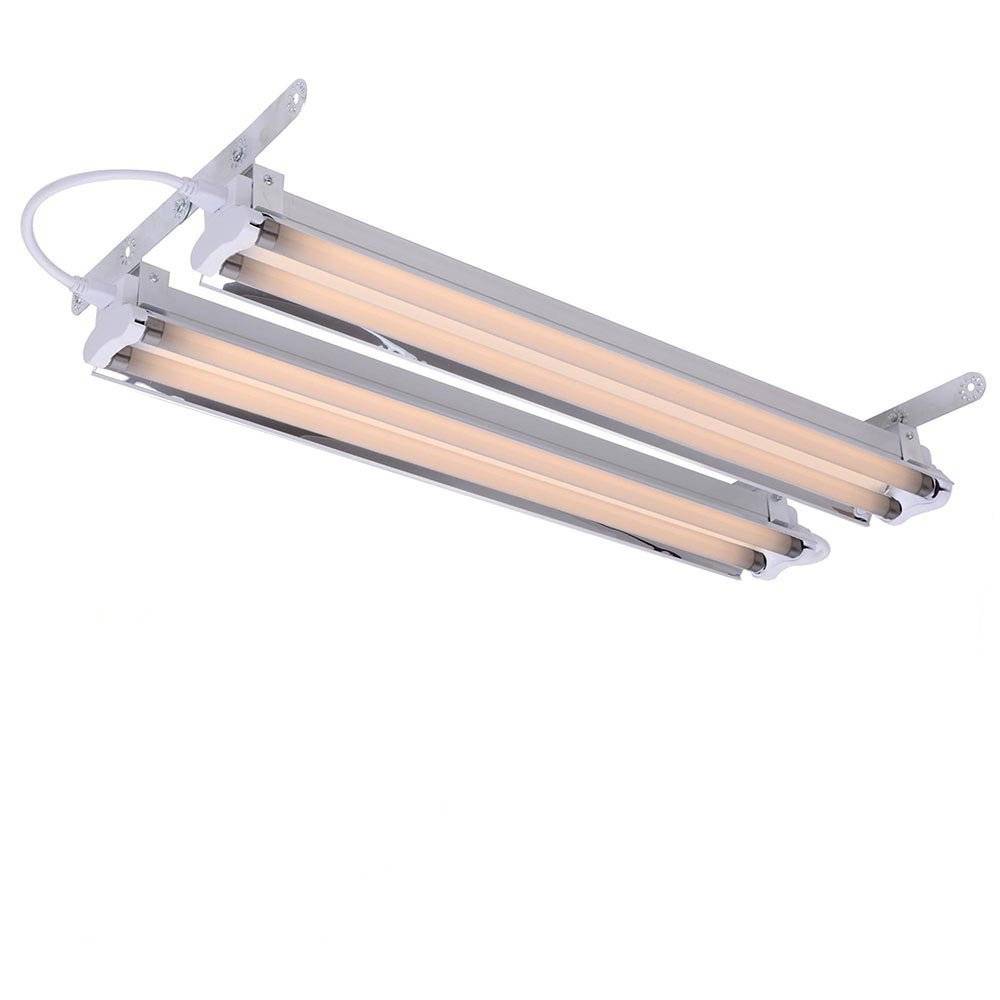
Maybe I could have gotten ballasts and sockets and bulbs.
Like you said, I got it just to add a little to the LED's
Im planning to use some tube UV and reflectors added in later
Modular and tuneable were major design considerations
Hydroponic Fixture Bloom Planting Growing Lamps (8) lamps total
Maybe I could have gotten ballasts and sockets and bulbs.
Like you said, I got it just to add a little to the LED's
Im planning to use some tube UV and reflectors added in later
Modular and tuneable were major design considerations
If you have any links to other uv specific threads feel free to share, I was gonna add it to my existing cob frame
I would love to see a grow without and a comparative grow with them side by side.
I would love to see a grow without and a comparative grow with them side by side.
Yes you need green
green spectrum on the LED ? no sure who you're answering.
I made a post where I took out one of two 4100K lights and threw in a red 3100K in flower. Also swapped a blue 6500K for a 3100K.
Still have one 4100K in there.
Yes you need green
Looking in to that still 550 nm and 5200k would be the peak color temp
Deep canopy penetration was the goal for that
Dion I think had made the suggestion that the COB is actually full spectrum
or peaks and is broad is the way I interpret it.
They all seem to lack in green.
While it's not really seen in the photosynthesis lab studies plants use it.
Green light after it passes through a leaf cell matrix I wonder how the light is effected ?
When light hits an object, it can be absorbed by the object, reflected off the object, pass right through the object (like glass)
Apparently the first leaf it passes through? Or is partially reflected ?
Makes me wonder,
Green Light
The visible green light has a wavelength of about 510 nm. Grass, for example, appears green because all of the colors in the visible part of the spectrum are absorbed into the leaves of the grass except green. Green is reflected, therefore grass appears green
What is chlorophyll?
Chlorophyll is a compound that is known as a chelate. A chelate consists of a central metal ion bonded to a large organic molecule, composed of carbon, hydrogen, and other elements such as oxygen and nitrogen.
Chlorophyll has magnesium as its central metal ion, and the large organic molecule to which it bonds is known as a porphyrin. The porphyrin contains four nitrogen atoms bonded to the magnesium ion in a square planar arrangement. Chlorophyll occurs in a variety of forms.
The structure of chlorophyll a.
Chlorophyll does not contain chlorine as the name might suggest; the chloro- portion stems from the Greek chloros, which means yellowish green. The element chlorine derives its name from the same source, being a yellowish-green gas.
Generally you can say that plants absorb primarily red (or red/orange) and blue light.
It's within the chloroplasts that all this light absorbing happens. The chloroplasts take the energy harnessed in these light rays and use it to make sugars for the plant to use in building more plant material = photosynthesis. Within the chloroplasts, the molecules that actually do the absorbing are called photopigments (freckles are examples of pigments in humans). A plant has a mix of different types of photopigments so that it can absorb light at different colors. A plant can have one photopigment devoted to absorbing deep blue, another devoted to absorbing yellow,
another for orange, and another for red. When full spectrum light, like sunlight shines on a plant all the photopigments are activated and absorb their "specialty" color. A plant's chloroplasts get all the actions of the photopigments coordinated so that they're all working to harness most of the sun's light rays and make plant food. If there is only one color of light shining on a plant, then only a certain group of photopigments are
active. The plant won't be able to make as much sugar or plant food as when there is full spectrum light shining on it and it may suffer generally. Not only will the plant not have enough light to make lots of food, but the plant uses these different color lights to signal all sorts of other internal processes. If, for example, only blue light was shining on the plant, then all the red-light triggered processes would not occur. Eventually the plant may die because of this lack of full spectrum light and certain processes not happening. It would be like in your body if suddenly your liver couldn't function anymore. Eventually you would die. So, plants need full spectrum (all the colors of the rainbow) light to live productively.
I have really just started looking into this green light briefly anyone else used it?
green spectrum on the LED ? no sure who you're answering.
I made a post where I took out one of two 4100K lights and threw in a red 3100K in flower. Also swapped a blue 6500K for a 3100K.
Still have one 4100K in there.
I must have been writing that book missed this post, how did that 4100k affect things. Notice anything worth mention?
I must have been writing that book missed this post, how did that 4100k affect things. Notice anything worth mention?
Its only been two days. My original reason for having it was due to reading through the behemoth of all 100+ pages of the Official PL-L club everything you need to know about PL-L's. Its a little too big to comb back through that maybe page 80-100 this happened.
This was a year ago but I remember a member having in one or two 4100K lights and swapping them all out for more red half way though in flower. He said he noticed a difference worth of note and wouldn't do it again.
Its just been two days for me and I still have a 4100K in the middle. To early to tell if they are responding well to the 3100K's in favor. I did however get rid of a Blue 6500K. That spectrum is now completely gone which I wish was still there.
I have three lights and three spectrums to mix like I said before b ut i like to Keep it 2:1 ratio not 1:1:1. I don't really feel like rotating the bulb positions to provide even distribution. 5 would be more ideal but i just cant fit that space wise.
There are much more photopigments than I previously suspected
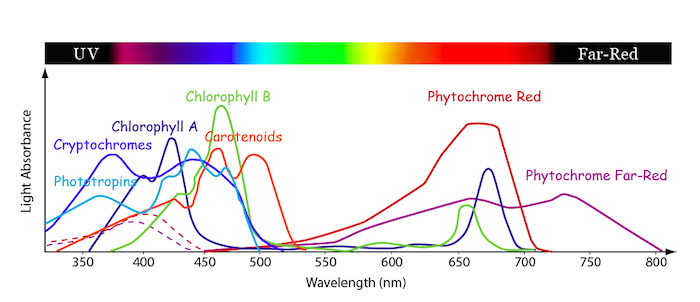
This image may explain why the 2:1 or 3:1 ratios are beneficial?
I like what your doing with lights being able to change the spectrums
It's going to be nice to post results like you did that's where all the work and studying pays off
Hope to get 1.5 gm per watt
On average, HPS lights achieve a yield of .5 grams per watt. For comparison,
LED lights usually achieve 1g to 1.5g per watt, making them up to three times more effective.Oct 22, 2015
4- 5gal in 3x3 Scrog high hopes 500+ watts with critical it might be possible?
500+ watts with critical it might be possible?
Veg 6 weeks
This image may explain why the 2:1 or 3:1 ratios are beneficial?
I like what your doing with lights being able to change the spectrums
It's going to be nice to post results like you did that's where all the work and studying pays off
Hope to get 1.5 gm per watt
On average, HPS lights achieve a yield of .5 grams per watt. For comparison,
LED lights usually achieve 1g to 1.5g per watt, making them up to three times more effective.Oct 22, 2015
4- 5gal in 3x3 Scrog high hopes
Veg 6 weeks
OranguTrump
Crotchety Old Crotch
This is the side view of the cob array
https://www.icmag.com/ic/picture.php?albumid=70564&pictureid=1690770View Image
Not seeing pics - just thought I'd let ya know.

